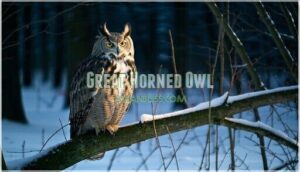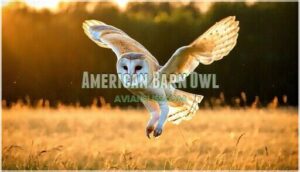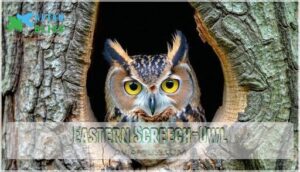This site is supported by our readers. We may earn a commission, at no cost to you, if you purchase through links.

The Great Horned Owl, with its distinctive "ear" tufts, dominates woodlands and suburbs year-round.
Barn Owls haunt old structures with their ghostly white faces, while Barred Owls call "who-cooks-for-you" from swampy areas.
The diminutive Eastern Screech-Owl hides in tree cavities, perfectly camouflaged.
Winter brings the elusive Long-eared Owl to dense thickets and the magnificent Snowy Owl to open fields.
These silent hunters have adapted to Indiana’s diverse landscapes, from urban parks to remote wetlands, making them surprisingly accessible to patient observers who understand their preferred hunting times and habitat needs.
Table Of Contents
- Key Takeaways
- Owl Species Found
- Physical Owl Characteristics
- Owl Behavior and Habitat
- Threats to Owls in Indiana
- Owl Conservation Efforts
- Frequently Asked Questions (FAQs)
- What is the most common owl in Indiana?
- Is it good to have an owl in your yard?
- What to do if you find an owl in your yard?
- Why are owls hanging around my house?
- Are owls good to have in your yard?
- Why put an owl in your yard?
- What kind of owls hoot at night?
- What time of year do owls breed?
- Are owls active during the daytime?
- How do owls communicate with each other?
- Conclusion
Key Takeaways
- You’ll find six fascinating owl species in Indiana year-round and seasonally, from the common Great Horned Owl with distinctive ear tufts to the elusive winter-visiting Snowy Owl in open fields.
- You can easily identify these nocturnal hunters by learning their unique calls – Great Horned Owls‘ classic "hoo-hoo-hoo," Barred Owls’ "who-cooks-for-you," and Eastern Screech-Owls’ trills and whinnies.
- You’re helping protect these magnificent birds when you avoid using rodenticides and pesticides, install appropriate nest boxes, and preserve natural habitats like old-growth forests and grasslands.
- You’ll have the best success spotting owls by understanding their preferred hunting times (dawn and dusk), habitat needs (woodlands for Great Horned, open fields for Snowy, swampy areas for Barred), and seasonal patterns.
Owl Species Found
You’ll find eight distinct owl species across Indiana, with three calling the state home year-round and others visiting during winter months.
These remarkable nocturnal hunters range from the tiny Northern Saw-whet Owl to the impressive Snowy Owl that occasionally ventures south from the Arctic tundra.
Great Horned Owl
Since you’re scanning Indiana’s twilight landscape for these magnificent hunters, you’ll likely encounter the Great Horned Owl first.
When darkness falls, listen for their iconic "hoo-hoo-hoo" vocalizations echoing through woodlands and suburban areas where these adaptable Indiana owls thrive.
Looking at the paragraph’s tone and style, here’s a short, engaging blockquote:
Listen closely—those haunting hoots reveal Indiana’s most adaptable nighttime predator.
Their diverse Great Horned diet includes everything from rodents to skunks, making them successful across various owl habitats throughout the state’s forests and neighborhoods.
These owls, while of least concern, still face population decline due to human interference.
American Barn Owl
American Barn Owls grace Indiana’s open fields with their distinctive heart-shaped faces and silent flight.
You’ll recognize their pale plumage and dark eyes as they hunt rodents across grasslands.
These state-endangered barn owl species face habitat loss but benefit from active owl conservation efforts including nest box programs.
Their global distribution is nearly worldwide, absent only from high latitudes.
Key Features to Help with Owl Identification:
- Heart-shaped white facial disk with cinnamon brown borders distinguishes them from other owl species
- Barn Owl Diet consists mainly of voles and mice, making them excellent natural pest controllers
- Distinctive raspy screeching Owl Vocalizations replace typical hooting sounds you’d expect from owls
Their Conservation Status remains critical in Indiana, with fewer than 50 nests found annually.
Habitat Restoration through grassland preservation and nest box installation in suitable owl habitats helps support these "farmer’s friends" in their ongoing survival.
Barred Owl
You’ll recognize barred owls by their distinctive "**Who cooks for you?
**" hooting calls echoing through Indiana’s mature forests.
These brown-and-white striped owl species prefer wooded swamps and forest interiors, maintaining 700-acre territories where they hunt mice, voles, and occasionally wade for crayfish.
Their deep brown eyes and expressive facial disks make owl identification straightforward during twilight observations, allowing for easy recognition of these barred owls with their distinctive calls.
Eastern Screech-Owl
Although you’ve spotted the occasional screech owl in your neighborhood, identifying this master of disguise requires understanding its unique traits.
These compact owls showcase remarkable adaptability through their distinctive features:
- Screech-Owl Calls – haunting trills and whinnies echo through backyards at dusk
- Color Morphs – red and gray plumage variations provide perfect camouflage against tree bark
- Urban Adaptation – thrives in wooded suburbs and parks throughout Indiana
- Diet Variations – hunts everything from insects to small mammals using sit-and-wait tactics
The screech owl’s ability to thrive in various environments is a testament to its remarkable adaptability.
Long-eared Owl
Long-eared owls remain one of Indiana’s most elusive winter visitors, with their prominent ear tuft function serving as perfect camouflage techniques among dense branches.
You’ll rarely spot these secretive hunters during daylight hours due to their expert roosting behavior.
| Characteristic | Details |
|---|---|
| Size | 13.8-15.8 inches long |
| Wingspan | 35.4-39.4 inches |
| Weight | 7.8-15.3 ounces |
| Diet | Small mammals (98%), few birds |
| Status | Special Concern species |
These longeared owls excel at nocturnal hunting using exceptional hearing to locate prey in darkness.
Snowy Owl
Witnessing these Arctic visitors during winter irruptions offers you an unforgettable bird sighting experience.
Snowy owls travel from their Arctic breeding grounds every 4-5 years when food becomes scarce, creating irruption patterns that bring them to Indiana’s open fields.
Crawford sightings demonstrate their preference for tundra-like habitats, where diurnal hunting distinguishes them from other owls in Indiana.
Their conservation status remains stable despite declining Arctic conditions.
Physical Owl Characteristics
When you spot an owl in your backyard, you’ll notice these birds come in dramatically different sizes, from the massive Great Horned Owl with its five-foot wingspan to the tiny Eastern Screech-Owl that’s smaller than a robin.
Understanding each species’ physical traits helps you identify which feathered hunter you’re watching and appreciate the remarkable adaptations that make these nocturnal predators so successful.
Size and Wingspan
When you’re spotting types of owls in Indiana, sexual dimorphism becomes apparent through size differences between males and females.
You’ll notice females typically showcase larger plumage size and average wingspan measurements than their male counterparts, a common trait in owl behavior across regional variation.
Here are key size facts for wildlife observation:
- Snowy Owls dominate with wingspans reaching 57.1 inches, making them Indiana’s largest visiting species
- Great Horned Owls measure 18-25 inches tall with 5-foot wingspans, showing significant sexual dimorphism
- Eastern Screech-Owls represent the smallest at just 6-10 inches, proving size doesn’t limit hunting effectiveness
- Juvenile size often matches adult dimensions within their first year, though flight skills develop gradually
- Barred and Barn Owls fall in the middle range, with 16-21 inch heights and 3-4 foot wingspans
Weight
You’ll discover that owl weight varies dramatically between species, from the feather weight northern saw-whet owl at just 2.5 ounces to the hefty great horned owl reaching 5.5 pounds.
These weight adaptations directly influence flight efficiency and prey size preferences.
Bone density remains remarkably low across all types of owls found in Indiana and Ohio wildlife areas, enabling silent flight while maintaining structural strength for capturing varied prey.
Lifespan
Owl longevity varies dramatically across Indiana’s six species.
Great horned owls live longest, averaging 13-25 years in the wild with captive lifespan reaching 50 years.
Barn owls face harsh wild mortality, surviving just 2-4 years typically.
Barred owls reach up to 24 years, while screech-owls average 3-7 years.
Aging factors include predation, vehicle strikes, and food availability affecting bird population dynamics.
Owls in captivity often benefit from consistent care and safety, leading to extended lifespans.
Owl Behavior and Habitat
You’ll discover that Indiana’s owls have adapted fascinating hunting strategies and habitat preferences that make them surprisingly easy to spot once you know what to look for.
Each species exhibits unique behaviors, from the snowy owl’s preference for open fields that resemble their Arctic tundra home to the secretive saw-whet owl’s nocturnal movements through dense forests.
Nocturnal Hunting
When darkness falls, you’ll witness nature’s most efficient predators spring into action.
Their silent flight, enhanced by specialized feather adaptations, allows owls to approach prey undetected while asymmetrical ear placement enables precise sound triangulation.
These nocturnal hunters employ sit-and-wait strategies, using exceptional hearing to detect mouse rustling beneath snow before swooping down with deadly accuracy and razor-sharp talons.
Nesting Preferences
In nature’s real estate market, nest site selection determines owl success.
You’ll find great horned owls commandeering hawk nests while screech owls squeeze into cavity size needs of old woodpecker holes.
Barn owls prefer drafty barns with minimal nesting material use, whereas barred owls craft clutch size variation from two to four eggs.
Breeding season timing and nesting success factors depend heavily on owl habitats offering protection from predators and weather extremes.
Providing suitable nesting structures can greatly aid owl populations.
Prey Preferences
Indiana’s owls showcase remarkable dietary diversity through their hunting strategies and prey preferences.
You’ll find these predators targeting everything from tiny insects to substantial rodents, with each species developing specialized techniques.
Great Horned Owls dominate with powerful talons that capture rabbits and skunks, while Barn Owls excel at rodent consumption, swallowing mice whole before regurgitating distinctive owl pellets containing bones and fur.
They develop these skills to thrive in their environments, making them efficient hunters with unique characteristics, such as the ability to fly silently and have powerful talons.
Open Field Habitats
You’ll find these magnificent hunters thriving in expansive agricultural landscapes where rodent abundance peaks during winter months.
Open field habitats provide the tundra resemblance that triggers snowy owl irruptions, especially areas near water source proximity that support diverse prey populations. Open habitats comprise grasslands and savannas.
- Field hunting styles vary from patient ground-sitting to active flight patterns over farmland
- Owl habitats include airports, golf courses, and large pastures that mimic Arctic conditions
- Bird field habitat selection focuses on areas with minimal tree cover for ideal hunting visibility
Threats to Owls in Indiana
While you’re out spotting these magnificent birds, it’s important to understand the serious challenges they face in Indiana’s changing landscape.
From habitat destruction to pesticide poisoning, owls must navigate an increasingly dangerous world just to survive.
Habitat Loss
You’re watching owl habitats disappear faster than you’d expect.
Forest Fragmentation breaks up continuous woodlands, while Urban Sprawl eliminates nesting sites.
Wetland Destruction reduces prey availability, and Farmland Conversion removes hunting grounds, creating Prey Depletion that forces owls elsewhere.
| Threat Type | Primary Impact | Affected Species |
|---|---|---|
| Forest Fragmentation | Reduces nesting sites | Great Horned, Barred |
| Urban Sprawl | Eliminates hunting grounds | Barn, Screech |
| Wetland Destruction | Decreases prey availability | All species |
Pesticides and Rodenticides
Anyone who uses rat poison puts owls at serious risk through secondary poisoning. When you scatter rodenticides around your property, rodents consume the toxins and become easy prey for hunting owls.
These contaminated meals deliver fatal doses that accumulate in owl tissues, causing internal bleeding and death. Pesticide regulations don’t adequately protect wildlife from these rodenticide effects, making owl mortality a growing concern.
Choose safe alternatives like snap traps to protect these magnificent hunters while controlling rodents. Implementing organic farming practices can further reduce reliance on harmful chemicals, promoting a safer environment for owls and other wildlife through organic farming and harmful chemical reduction.
Predation
While chemicals pose external threats, predation creates natural pressure on owl populations through complex food webs.
You’ll find that hunting techniques vary among species, with great horned owls targeting other owls while hawks compete for similar prey.
Seasonal predation intensifies during winter when food sources become scarce, forcing owls into urban areas where cats and dogs threaten ground-dwelling species.
Climate Change
Arctic warming disrupts everything you’d expect from owl habitats.
As temperatures rise, prey scarcity forces owls to travel further for food, creating migration shifts that throw off their natural timing.
These habitat changes affect bird breeding success across species, while conservation impact studies show declining bird habitat suitability.
Climate change reshapes bird migration patterns and threatens the delicate balance of bird food supply systems, causing prey scarcity, and ultimately impacting owl habitats.
Owl Conservation Efforts
While Indiana’s owls face mounting challenges from habitat loss and pesticides, dedicated conservation efforts are making a real difference in protecting these nocturnal hunters.
You can actually help support owl populations through simple actions like installing nest boxes, reducing pesticide use, and participating in citizen science programs that monitor local owl communities.
Nest Box Installation
You can create safe havens for owls by installing nest boxes designed specifically for their needs.
Proper box dimensions matter—screech owls need 8×8 inch floors while barn owls require 12×16 inches.
Strategic placement strategies involve mounting boxes 10-15 feet high on poles or trees, facing away from prevailing winds.
Owls often prefer natural tree cavities for nesting.
Essential Installation Steps:
- Predator Guards – Install metal baffles below boxes to prevent climbing predators
- Maintenance Tips – Clean boxes annually after breeding season ends
- Community Involvement – Partner with local birdwatching groups for monitoring programs
Pesticide Reduction
Reducing pesticide use protects owls from secondary poisoning when they consume contaminated prey.
You’ll create safer environments by choosing integrated pest management over broad-spectrum chemicals.
| Harmful Practice | Owl-Safe Alternative |
|---|---|
| Rodenticides (rat poison) | Snap traps, exclusion methods |
| Broad-spectrum insecticides | Targeted biological controls |
| Persistent herbicides | Manual weeding, cover crops |
Pesticide Alternatives like natural predators and mechanical controls support Ecosystem Health while preventing Owl Poisoning.
Safe Farming practices reduce Rodenticide Effects, ensuring wildlife conservation through responsible environmental stewardship.
Habitat Preservation
You’ll transform ordinary spaces into protected areas that safeguard critical owl habitats for generations to come.
Land conservation initiatives preserve the natural habitats these magnificent birds depend on, ensuring roosting sites and water sources remain untouched by development.
You can support owl habitat preservation by purchasing specialized products.
Effective wildlife protection strategies include:
- Establishing protected areas near known owl territories
- Maintaining prey abundance through sustainable farming practices
- Preserving old-growth forests that provide essential roosting sites
Public Education and Awareness
You’re the backbone of owl conservation through education and reporting.
When you spot an owl, document it on platforms like eBird.org to help scientists track populations and migration patterns.
Join local conservation programs that monitor nesting sites and conduct citizen science projects.
Share your ethical observation experiences with friends and neighbors to spark interest in owl identification and wildlife education.
Educational workshops at nature centers teach proper observation techniques while building community involvement.
Consider owl themed learning for further study.
Your participation in bird education programs creates ripple effects, inspiring others to become wildlife stewards.
Frequently Asked Questions (FAQs)
What is the most common owl in Indiana?
You’ll most commonly spot Great Horned Owls in Indiana.
They’re year-round residents found in forests, parks, and even urban areas throughout the state, making them the most frequently encountered owl species.
Is it good to have an owl in your yard?
Having owls in your yard is beneficial.
They’re natural pest controllers, eliminating rodents that damage gardens and spread disease.
You’ll enjoy their silent flight and haunting calls, plus they indicate a healthy ecosystem with adequate prey and habitat.
What to do if you find an owl in your yard?
Stay calm and observe the owl from a distance.
Don’t approach, feed, or disturb it. Most owls are just resting and will leave naturally.
Contact local wildlife authorities if the owl appears injured or stays multiple days.
Why are owls hanging around my house?
Owls might hang around your house because you’re providing ideal hunting grounds. Your yard likely offers abundant prey like mice, voles, or small birds, plus good perching spots for surveillance.
Are owls good to have in your yard?
Yes, owls are excellent yard residents.
They’re natural pest controllers, silently hunting mice, rats, voles, and insects that damage gardens and spread disease.
Having owls nearby means fewer rodents eating your plants and vegetables, as they are natural pest controllers.
Why put an owl in your yard?
Want natural pest control? You’ll attract owls that hunt mice, rats, and other rodents plaguing your property.
They’re silent, efficient hunters working night shifts while you sleep, reducing harmful pest populations naturally without chemicals.
What kind of owls hoot at night?
Several owl species commonly hoot at night, including Great Horned Owls with their classic "hoo-hoo-hoo, hoo-hoo" call.
Barred Owls making "who-cooks-for-you" sounds, and Eastern Screech Owls producing soft trills or whinnies.
What time of year do owls breed?
Like clockwork from ye olde times, most owls breed during spring months (March-June) when food’s abundant. You’ll find they’re syncing their nesting with prey availability to successfully raise their young.
Are owls active during the daytime?
Most owls hunt at night, but you’ll find several species active during daylight hours.
Snowy owls hunt both day and night since they’re adapted to Arctic conditions with continuous daylight during summer months.
How do owls communicate with each other?
You’ll hear owls communicate through various vocalizations including hoots, screeches, barks, and clicks.
They use different calls for territory marking, mate attraction, warning signals, and parent-chick communication, with each species having distinct vocal patterns.
Conclusion
Watching these owls in Indiana might seem like waiting for Bigfoot to order takeout, but they’re actually more common than you’d think.
You’ll discover that patience pays off when you learn their schedules and favorite hangouts.
Whether it’s the Great Horned Owl’s suburban reign or the Snowy Owl’s winter visits, each species offers unique viewing opportunities.
By supporting conservation efforts and creating owl-friendly spaces, you’re ensuring future generations can experience these remarkable nocturnal hunters thriving across Indiana’s landscapes.
- https://a-z-animals.com/blog/discover-types-owls-indiana/
- https://birdwatchingcentral.com/owls-in-indiana/
- https://indianaaudubon.org/2024/11/25/a-guide-to-responsible-owl-viewing/
- https://www.in.gov/dnr/fish-and-wildlife/wildlife-resources/animals/barn-owl/barn-owl-nest-webcam/
- https://www.barnowlbox.com/barn-owls-by-state/















